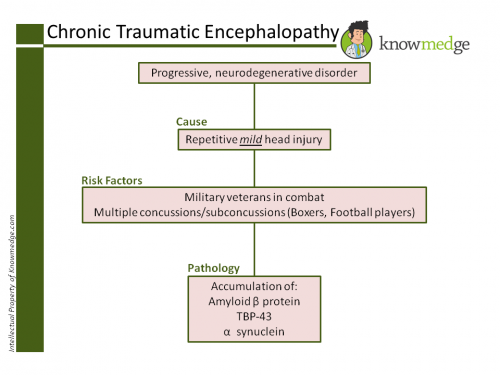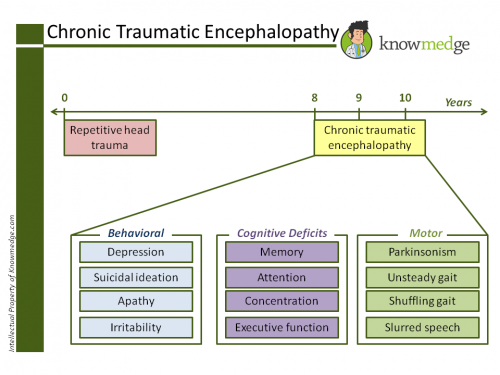Will Smith’s Concussion teaches us what we need to know about Chronic Traumatic Encephalopathy (CTE) for Boards & Wards
This Christmas marks the release of a likely Academy Award contender highlighting the medical research community’s exposing of the brutal damage done to the brains of former professional football players. In addition to being a well-reviewed film, Concussion, starring Will Smith could even provide medical students, residents and internists answers to a question or two they’ll encounter on their shelf test, ABIM Boards, USMLE Steps, or In-Training Exams (ITE).
As depicted in the movie, the neurologic research effort is led by the forensic pathologist Bennet Omalu who was the first to publish reports of Chronic Traumatic Encephalopathy (CTE) in football players. His work began in 2002, when he examined the body and brain of 50-year-old former Pittsburgh Steelers center Mike Webster. [1]
Decades after a 17-year career, Webster demonstrated a drastic decline in his mental abilities, becoming depressed, forgetful and violent. In July 2005, Omalu’s groundbreaking study “Chronic Traumatic Encephalopathy in a National Football League Player” was released in the journal Neurosurgery, paving the way for additional research on former football players and the subsequent efforts by the NFL to conceal data that implicated their sport in the deterioration of previously healthy young athletes. Now a professor at the University of California, Davis, Dr. Omalu is credited as “the first to identify, describe and name Chronic Traumatic Encephalopathy [CTE] as a disease entity in football players and wrestlers.” [2]
Let’s review chronic traumatic encephalopathy (CTE) in the context of the ABIM Boards, USMLE Steps, and In-Training Exams (ITE). Although tests assess patients’ knowledge of well-established, commonly encountered medical conditions like hypertension, coronary artery disease, diabetes, etc— relatively new diagnoses making the headlines in the mainstream press are fair game, provided that they are backed by scientific data as is the case with ITE.
In MKSAP 17, the latest edition of the American College of Physicians (ACP) publication, there is a question that actually addresses chronic traumatic encephalopathy.
It begins:
The patient is retired from a 13-year career playing professional football…
Is there any other diagnosis you have seen that provides this type of information in the patient’s background?
The clinical vignette specifically mentions that the patient has no significant medical history “other than minor football injuries.” The adjective minor may lead some to believe that the injuries don’t have a long-term effect on the subject’s health. However, the shocking aspect of CTE is that the daily grind of competitive football (or boxing)—in the absence of season-ending fractures or game-ending concussions—is enough to cause problems years and even decades later.
CTE is a progressive, neurodegenerative disorder. While not consistent across the board, the accumulation of amyloid β protein, TDP-43, and α-synuclein protein is noted in some patients.

Eight to 10 years typically pass after the repeated brain injuries before symptoms develop. The cerebral damage causes cognitive impairment, behavioral deficits, and motor symptoms.

- Cognitive impairment is characterized by impaired concentration, poor short-term memory, executive dysfunction, and poor judgment.
- Behavioral symptoms include depression, irritability, aggression, violent behaviors, emotional lability, impulsivity, and suicidality.
- Motor symptoms are common and include parkinsonism, unsteady gait, shuffling gait, slurred speech, and motoneuron disease.
References
[1] Laskas, Jeanne Marie. “The Doctor the NFL Tried to Silence.” Wall Street Journal. http://www.wsj.com/articles/the-doctor-the-nfl-tried-to-silence-1448399061?mod=e2tw. Accessed December 22, 2015.
[2] https://www.ucdmc.ucdavis.edu/pathology/our_team/faculty/OmaluB.html
[3] JE Bailes, et al. “Role of subconcussion in repetitive mild traumatic brain injury.”J Neurosurg. 2013 Nov;119(5):1235-45. 2013 Aug 23. http://www.ncbi.nlm.nih.gov/pubmed/23971952
[4] BP Lucke-Wold et al. Journal of Neurosurgery. 2015 Sep 18:1-16. “Endoplasmic reticulum stress implicated in chronic traumatic encephalopathy.”
[5] MKSAP 17. Dementia associated with traumatic brain injury. https://mksap17.acponline.org/app/groups/nr/topics/mk17_a_nr_s5/sections/mk17_a_nr_s5_4







